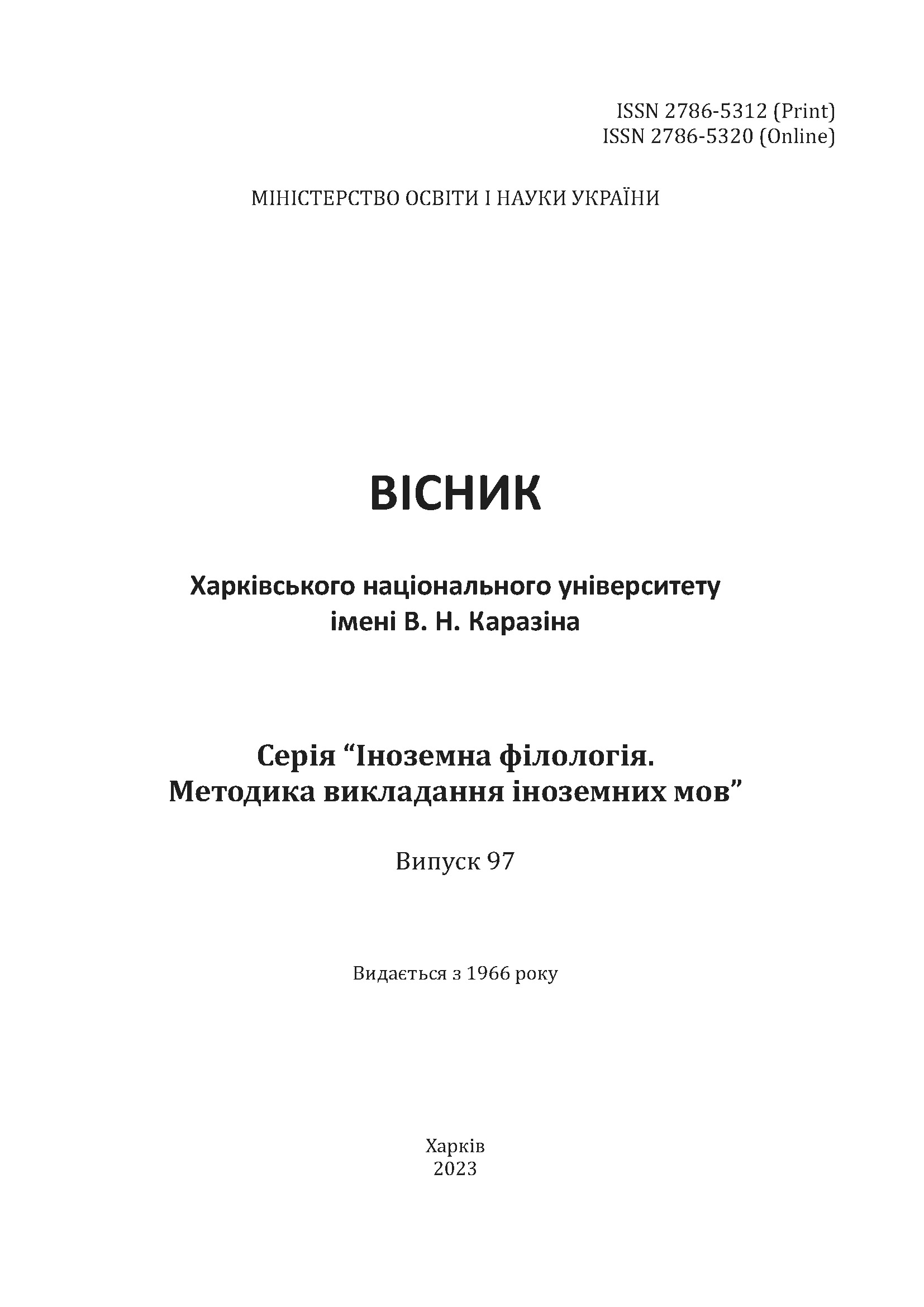Sources of influence on rendering biblical geographical names into Ukrainian. Part 1.
Abstract
The article examines the coincidences and discrepancies in the rendering of geographical names in the most common translations of the Bible into Ukrainian. The material of the study comprised 172 geographical names from the text of the Old Testament (Genesis, Exodus, Numbers, and Deuteronomy) in translations from the Hebrew original, as well as from the Synodical and English-language intermediary texts. For the purpose of this analysis, all 172 names were divided into six categories, depending on the degree of coincidence of their spelling in Ukrainian, where in category 1 the rendering of the proper name coincides in all versions of the translation, and in category 6 it does not coincide in any of its six versions. The other categories differed in the proportion of such matches. This article discusses the results of the analysis of the first four categories, which allow to draw a preliminary conclusion that some of the studied translators were guided mainly by the Ukrainian tradition (recorded in the translations of I. Ohienko and I. Khomenko), even when they did not translate from the Hebrew original but from other intermediary texts, in particular, from the English-language (New World Bible). Filaret was mainly influenced by the synodal translation, only occasionally switching over to the Ukrainian tradition. On the other hand, the remaining translators such as Ohienko, Khomenko, and Hyzha have a distinctly Ukrainian orientation, relying on the long tradition of national translation. Turkoniak’s translation stands apart, as he adheres to his own principles of rendering proper names, making his translation unlike any other tradition in this respect. Given the undoubted erudition and qualifications of this translator, it can be assumed that his innovations are the most valuable ones in the modern interpretation of the texts of Scripture.
Downloads
References
Bibla, S. V. (1997). Sklad, dzherela i shliakhy formuvannia ukraiinskoii tserkovnoii terminolohiii (nazvy tserkovnykh chyniv i posad). (Avtoreferat kandydatskoi dysertatsii) [Ukrainian church-related terminology: Composition, sources and ways of formation. [Philology PhD thesis synopsis]. – Taras Shevchenko Kyiv National University (in Ukrainian).
Bibliia. Knyhy Sviaschennoho Pysannia Staroho i Novoho Zavitu: v ukrains’komu perekladi z paralel’nymy mistsiamy (2004). Pereklad Patriarkha Filareta (Denysenka).
(The Bible. Books of the Holy Scriptures of the Old and New Testament: in Ukrainian translation with parallel passages (2004). Translation by Patriarch Filaret (Denysenko). Kyiv: Publication of the Kyiv Patriarchate of the Ukrainian Orthodox Church-Kyivan Patriarchate (in Ukrainian).
Bibliia. Pereklad Novoho Svitu ukrains’koiu movoiu (2014). (The Bible. New World Translation into Ukrainian). (in Ukrainian). Retrieved from: httpp//vvv.jv.org. (in Ukrainian).
Bibliia abo Knyhy Sviatoho Pysma Staroho i Novoho Zapovitu (2015). Iz movy davnoyevreiskoii i gretckoii na ukrayinsku doslivno nanovo perekladena (pereklad profesora I. Ohienko) [Bible or Books of Holy Scripture of Old and New Testaments anew translated into Ukrainian from Old Hebrew and Greek by Professor Ivan Ohienko]. Kyiv: Ukrainian Bible Society. (in Ukrainian).
Bibliia (2011) (chetvertyi povnyi pereklad z davnogretskoii movy), pereklad iieromonakha o. Rafaiila (Romana Turkoniaka) [Bible, fourth full translation into Ukrainian from Old Greek by father Rafail (Roman Turkoniak)]. Lviv: Ukrainian Bible Society. (in Ukrainian).
King James Version of the Bible. Retrieved from: (in English).
Matsko, L. I., Sydorenko, O. M. & Matsko, O. M. (2003). Stylistyka ukraiinskoii movy [Stylistics of the Ukrainian Language]. Kyiv: Vyshcha shkola Publ. (in Ukrainian).
Moroz, Y. A. (2017). Natsionalna tradytsiia bibliinykh perekladiv: filosofsko-relihiieznavchyi analiz. (Dys. dokt. filosof. nauk) [National Tradition of Bible Translation: Philosophic and Religious Aspects Analysis. (Philosophy Dr.Sc. thesis]. Zhytomyrskyi derzhavnyi universytet imeni Ivana Franka (in Ukrainian).
Novitnii pereklad Bibliyi Oleksandra Hyzhi (2013). [New Translation of the Bible by Oleksandr Hyzha]. Kyiv: Druk KT Zabelina- Filkovska Publ. (in Ukrainian).
Piddubna, N. V. (2000). Formuvannia nomenklatury nazv relihiinykh sporud v ukrayinskii movi. (Avtoreferat kandydatskoi dysertatsii) [Formation of the religious buildings names nomenclature in the Ukrainian language. [Philology PhD thesis synopsis]. Kharkivskyi derzhavnyi universytet imeni H.S.Skovorody (in Ukrainian).
Ponomariv, O.D. (1993). Stylistyka suchasnoii ukrayinskoii movy [Stylistics of Modern Ukrainian]. Kyiv: Lybid Publ. (in Ukrainian).
Puriaieva, N. V. (2001). Formuvannia ukrainskoii tserkovno-obriadovoii terminolohiyi (nazvy bohosluzhbovykh predmetiv). (Avtoreferat kandydatskoi dysertatsii) [Formation of Ukrainian church ceremonial terminology (names of church ceremonial objects). [Philology PhD thesis synopsis]. Taras Shevchenko Kyiv National University (in Ukrainian).
Shevchenko, L. L. (2007). Konfesiinyj styl [Confessional style]. Ukrayinska mova: Entsyklopediia. The Ukrainian language: Encyclopedia. 284 (in Ukrainian).
Sviate Pysmo Staroho i Novoho Zavitu (2007). Povnyi pereklad, zdijsnenyi za oryhinalnymy yevrejskymy, arameiskymy ta gretskymy tekstamy pid chas Druhoho Vatykanskoho Vselenskoho Soboru [pereklad o. Ivana Khomenka]. [Holy Scripture of Old and New Testaments. Full translation by Father Ivan Khomenko from the original Hebrew, Aramaic and Greek during the Second Ecumenical Council in Vatican]. Zhovkva: Misioner Publ. (in Ukrainian).
Tymoshyk, H. (2004). Bibliina proprialna leksyka v perekladi Sviatoho Pysma P. Kulisha ta I. Puliuia [Bible proprietary lexis in the translation of Holy Scripture by P.Kulish and I.Puliui]. Visnyk Lviv. un-tu, Seriia «Filolohiia». Ivan Franko Lviv National Univ. Messenger, 34(2), 204-208. (in Ukrainian).




